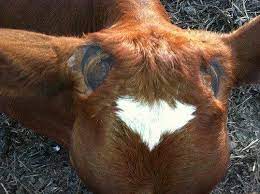
Dehorning is the removal of the horns from cattle. Cattle can have horns of different lengths, shapes and sizes, but all horns are detrimental to cattle from a welfare and production perspective and pose a potential safety risk to cattle handlers.
Tipping (removal of the insensitive sharp end of the horn) is not dehorning. It does little to reduce the disadvantages of having horned cattle, for example, it does not reduce bruising, and tipped cattle can still be a danger to other cattle and handlers.
Horned Cattle
- Hurt and damage other cattle, either deliberately or accidentally, especially when they are close to each other – at feeders, in yards and during transport.
- Get more injuries, bruising and hide damage than dehorned/polled cattle and are more aggressive towards other cattle.
- Are generally more difficult to handle in yards, and pose a greater risk to themselves and stock-handlers.
- Cause more damage to gates, yards, fences and troughs.
- Require more space per beast during road or rail transport, increasing transport costs
- Require more trough space in feedlots, and are generally not accepted into feedlots or for live export.
- Are harder to catch in a head bail and harder to apply ear tags, eg NLIS tags.
- Dehorned/polled cattle attract better prices, especially from lot-feeders and exporters.
When to Dehorn
The younger that cattle are dehorned, the better both for the calf and for the operator. Young calves suffer less pain and stress, have less risk of infection and have better growth rates. They are also much easier to handle and restrain.
- The best time to dehorn is before the horn bud attaches to the skull. This generally occurs at about two months old but can be quite variable. Dehorning is often possible earlier than this – it can be carried out as soon as the horn bud is visible. (Horn buds emerge more slowly in Bos indicus cattle, and they may need to be inspected later.) At this young age, the procedure is simpler, and there is relatively little bleeding. Dehorning at this young age is possible on more intensively managed farms.
- If dehorning cannot be done before the horn bud attaches, the procedure will cause more bleeding and leave a larger wound. However, it can be done successfully up to six months old, with extra care and good procedures.
- Dehorning of older animals is painful to the animal, significantly increases the risk of excessive bleeding and death due to blood loss, and greatly reduces the growth rate.
- Cool and dry conditions are best for dehorning. Hot, dry and dusty weather increases bleeding and the risk of infection. Wet weather increases the risk of infection and flystrike.
Facilities and Equipment Needed to Dehorn
Dehorning is best done in a calf cradle that allows good access to each horn site. Good restraint minimises the duration of the procedure and pain to the calf, reduces the risk of wound contamination and makes it easier for the operator.
- A head bail can be used as long as the movement of the head is restricted with a halter, nose grips or a chin bar.
- Holding the calf down on the ground is not recommended because the wound can become contaminated and infected.
- Haemorrhage control equipment including artery forceps and clean pressure pads should be available.
- All equipment must be clean, sharp and operating correctly before use. It must also be disinfected before each animal.

Dehorning Instrument Depend on Age of Calf

The dehorning instrument used will depend on the age of the calf:
- Hot iron – under two months old
- Dehorning knife – 2–3 months old
- Scoop dehorners – 2–6 months old
- Cup dehorners – 2–6 months old
Animals over six months old*:
- Guillotine dehorners – horn tipping only
- Surgical wire – horn tipping only
- Tippers – horn tipping only
- Horn saw – horn tipping only
*Horn tipping only unless under the direction of a veterinarian.
Caustic dehorning chemicals must not be used. They can spread into the eyes if the skin gets wet.
Removing horns with tools such as axes and hammers is completely inhumane, and is not permitted.
Dehorning Young Calf
The horn grows from the skin around its base – at different rates with different breeds. The horn bud is usually free-floating in the skin over the skull base in calves less than about two months old.
As the calf gets older, this horn bud attaches to the skull bone and a small horn forms.
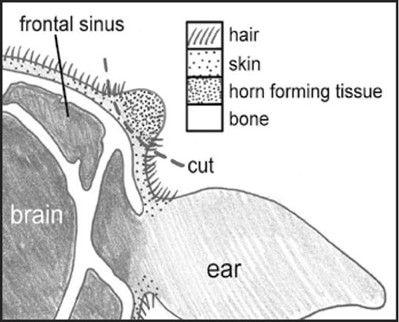
Dehorning Older Calf
After the horn bud attaches to the skull, the horn grows out from under the skin. It becomes a bony extension of the skull with the hollow centre of the horn opening into the frontal sinus. The brain lies directly under the frontal sinus covered by a thin layer of bone.
Dehorning after the horn attaches increases the risk of entering the frontal sinus and subsequent infection.
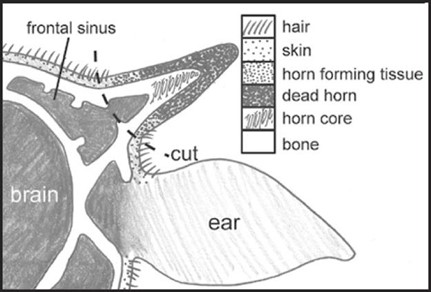
Scurs
Scurs, found on some polled cattle, are horns without an anchoring protrusion from the frontal sinus. They are usually small and are generally moveable as they are not connected to the skull. Cattle with scurs are considered equivalent to polled cattle for breeding and marketing purposes.

Dehorn Process
Plan your order of operations so that the most invasive procedures are done last. This helps reduce stress on the animal and the risk of infection from wound contamination. Vaccinate first, then ear tag or earmark, then brand, then castrate, then dehorn.
Before Dehorning: Pick a cool dry day. Hot weather increases bleeding; wet weather increases the risk of infection. Water the yards to reduce dust (but do not wet calves).
Cleanliness: Keep surgical instruments in a bucket with a suitable disinfectant solution (eg Savlon® or Hibitane®). Change the solution every 15–20 calves. Have separate buckets with antiseptic for instruments, and for washing and disinfecting hands.
Hot iron: Best for calves less than two months old as bigger horn buds will not fit in the ‘O’-shaped opening of the iron – which must be approximately 1cm larger than the bud all around.
Irons can be heated by gas, fire or battery (12 or 24 V).
Heat iron until ‘dull red’ hot.
Firmly restrain the calf’s head and apply the hot iron over the horn bud.
Roll the iron around and apply with sufficient pressure for just long enough to burn through the full thickness of the skin. The skin should look copper/bronze colour when finished.
The hot iron method is practically bloodless so the risk of infection is minimal.
Key to Successful Dehorning
Because the horn grows from the skin around its base, you just remove or destroy a complete ring of hair (1 cm wide) around the horn base.
Check that the excised ring is wide enough because some horns will grow if the ring is not complete.
A 1 cm wide ring of hair is enough – any more will make a larger wound, cause avoidable pain, and delay healing.
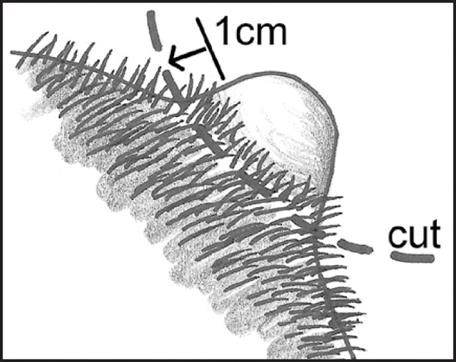
Dehorning Instruments
Dehorning Knife
 |
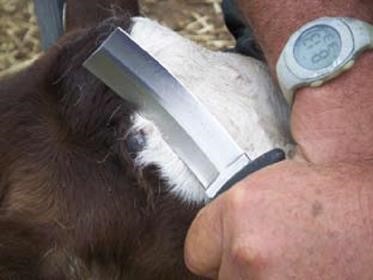 |
The knife has a sharp curved blade to ensure 1 cm of skin around the horn bud is removed. It is suitable for calves up to 2–3 months old but only if the horn bud is mobile and not attached to the skull.
- Remove the knife from the antiseptic solution and ensure it is sharp and clean.
- Start the cut about 2 cm from the base of the horn bud, apply firm pressure directed away from the operator’s hand, and firmly and quickly cut through the skin around the horn bud in one decisive action. This will slice off the horn bud level with the skull because of the curve in the blade.
- Inspect the removed horn bud to ensure there is a 1 cm ring of skin/hair around it. If not complete, make a second small cut to remove any remaining skin.
- Repeat on the second horn, clean off any tissue or hair from the cutting edge and replace the knife with an antiseptic solution.
Scoop Dehorner
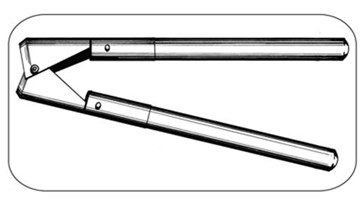 |
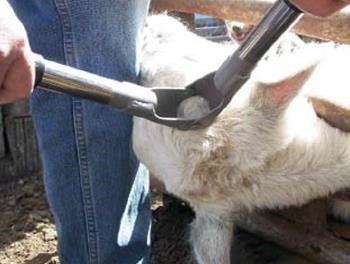 |
Suitable for calves 2–6 months old. Scoop dehorners are used preferably before the horn bud attaches, but can also be used after attachment provided the horn tissue is not too hard.
- Remove dehorners from antiseptic solution and ensure cutting edges are sharp and clean.
- Firmly restrain the calf’s head, hold the handles together, push the open scoop firmly down over the horn bud and then quickly open the handles outwards while maintaining firm downward pressure on the skin. This will scoop out the horn bud and surround 1 cm of skin around the bud.
- Inspect the removed horn bud to ensure there is a 1 cm ring of skin/hair around it. If not complete, make a second small cut to remove any remaining skin.
- Repeat on the second horn, clean off any tissue or hair from the cutting edge and replace dehorner with an antiseptic solution.
Cup Dehorner

Use cup dehorners only when the horn is too big or solid for scoop dehorners. Cup dehorners are best for calves up to six months old where the horn bud is already firmly attached.
- Remove the cup dehorners from the antiseptic solution and ensure the cups are sharp.
- Place the open half cups over the horn, ensuring a 1 cm skin margin, then close the handles quickly together so the sharp-edged cups cut through the skin and horn.
- Downward pressure on the cup may need to be applied by a second person to prevent the dehorner ‘riding up’ the horn, otherwise, some of the skin around the base of the horn may be missed.
- Cup dehorners can cause an unnecessarily large wound, and sometimes exposure of the frontal sinus, if used on too small a calf or if excessive downward pressure is applied.
- Inspect the removed horn to ensure there is a 1 cm ring of skin/hair around its base.
Horn Tipping
Horn tipping may be necessary for welfare reasons (for example, a horn is growing towards an animal’s head) or to reduce injury caused by aggressive horned cattle.
This would not be necessary if cattle are bred without horns or are dehorned at an early age.
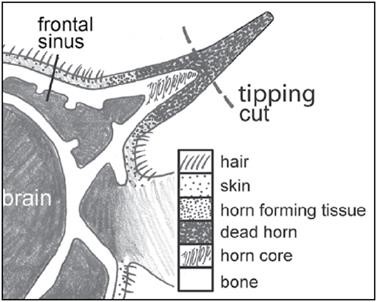
Controlling Bleeding
Animals dehorned at an early age before the horn attaches to the skull generally will not bleed excessively.
Any excessive bleeding should be controlled immediately as it will delay healing and can even be fatal.
Bleeding can be controlled by:
- Using artery forceps to grab and twist off any individual blood vessels that are leaking blood excessively.
- Applying firm pressure over the wound using a clean pad/gauze bandage and maintaining the pressure until the bleeding has stopped – generally after about two minutes.
- Applying a bandage wrapped firmly around the wound and skull if the above methods do not stop the bleeding. Pads or bandages must be carefully removed from the animal after 1–2 days. Do not leave them in place as they will attract flies.
- Cautery uses a hot iron to seal off blood vessels.
After Care
There is usually no need to apply a dressing or powder at the time of dehorning if cattle are dehorned at the correct age (less than six months) and not in wet or humid weather.
- Dressings and powders tend to retain moisture making the wound attractive to flies. They are not usually needed if the equipment and environment are clean, and the procedure is efficiently carried out on young calves.
- Control any excessive bleeding before the animal is released from the cradle/head bail.
- Reunite calves with their mothers as soon as possible after dehorning. They should be released from the cattle yards as soon as possible into a grassed, shaded holding paddock. There will be less bleeding if the animals are handled calmly and slowly before and after dehorning.
- Inspect the calves regularly, preferably daily, for about 10 days after dehorning for early detection of infection or flystrike. The symptoms usually seen are constant tossing of the head and/or a discharge from the wound. Be extra vigilant if the frontal sinus is exposed as this increases the risk of poor drainage and infection. This will not be a problem if the calves are dehorned at a young age before the horn growth involves the frontal sinus.
- Consult your veterinarian if wounds get infected. Generally, removing any matted hair and flushing the wound daily with a non-irritant antiseptic solution or saltwater will suffice. If necessary, apply a flystrike powder to the edges of the wound. More severe cases may require the administration of antibiotics.
Click here to view a video that explains dehorning.